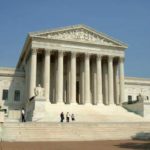Distance learning activities become civics for civic engagement when federal judges bring the rule of law, separation of powers, judicial independence, and jury service into students’ daily life. Student voice is incorporated into every activity. Teachers and students can explore the pillars of literacy: rule of law, separation of powers, and judicial independence. With the guidance of federal judges and attorney volunteers in virtual court hearings, students learn and practice civil discourse skills as the foundation of effective dispute resolution in the law and in life.
Moments in History: Remembering Thurgood Marshall
Few people know the legal mind of justices or judges as well as the law clerks who have worked with them. Justice Thurgood Marshall’s former law clerks offer unique insights into the character, values, and thought processes of the first African American to serve on the Supreme Court of the United States. In this 8.5-minute video called “Moments in History: Remembering Thurgood Marshall,” prominent lawyers reminisce about the examples of compassion and courage they saw in the life and work of this legal legend.
Using Case Studies in the Classroom
Street Law developed seven strategies for teaching about U.S. Supreme Court cases in secondary school classrooms. Use these strategies and Street Law’s case study summaries to supplement civics education about the Supreme Court’s role in the United States.
Environmental Laws Timeline Activity
Students will have to select 25 environmental laws in American history from a much larger list. Their goal is to produce their own timeline of American environmental law history to present to the rest of the class. In doing so, they will develop critical thinking and analytic skills and articulate the importance of the Rule of Law to protecting the environment.
Landmark Supreme Court Case: Roe v. Wade
The Supreme Court has the power to interpret the Constitution. Its rulings on cases determine the meaning of laws and acts of Congress and the president. Knowing the key decisions of the Supreme Court and the precedents they set is vital in understanding the meaning of laws, how our country has changed over time, and the direction the country is currently headed. In this lesson students will examine the case of Roe v. Wade.
2017 Supreme Court Nomination: Advising Senators Activity
Are you teaching about President Trump’s nomination of Judge Neil Gorsuch to the U.S. Supreme Court? Lead your students through an exploration of the process and have them take on a role as adviser to a senator in preparation for the Senate Judiciary Committee’s confirmation hearing.
Position Papers: Whole Woman’s Health v. Hellerstedt
Two position papers address the question in the 2016 Supreme Court case Whole Woman’s Health v. Hellerstedt: Is a Texas law imposing certain requirements on abortion clinics unconstitutional?
The Supreme Court: The Judicial Power of the United States

This lesson provides an introduction to the Supreme Court. Students will learn basic facts about the Supreme Court by examining the United States Constitution and one of the landmark cases decided by that court. The lesson is designed to help students understand how the Supreme Court operates.
The federal judiciary, which includes the Supreme Court as well as the district and circuit courts, is one of three branches of the federal government. The judiciary has played a key role in American history and remains a powerful voice in resolving contemporary controversies. The first governing document of this nation, the Articles of Confederation, gave Congress certain judicial powers, but did not establish a distinct federal court system.
What is the Judicial Branch?
This lesson exposes students to the judicial branch and the power of judicial review. They will read about an actual Supreme Court case, Torcaso v. Watkins, to see how the judicial branch used its power of judicial review to strike down an unconstitutional state law.
Campaign Finance
Students can hear Sal give an introduction to campaign finance up to and after Citizens United, including the difference between soft and hard money, the influence of PACs and super PACs, and the impact of the McCain-Feingold Act. They can then follow that up with an in-depth video on Citizens United v. FEC in which Sal discusses the background and holdings of the case with scholars Richard Hasen, professor of law at UC Irvine School of Law, and Bradley Smith, former chairman of the FEC. Teachers can then assign an exercise to their students aligned to the current AP Government and Politics exam to assess how well they understood the content of the lesson.